Chapter 6 - Light - Reflection of Light Exercise 245
Question 1
What do you mean by light?
Solution 1
Light may be defined as the radiant energy which produces in us the sensation of sight. Light itself is invisible but makes other objects visible.
Question 2
Give three distinctions between sound and light waves.
Solution 2
Three distinctions between light and sound waves are
(a). Light waves can travel through vacuum while sound waves cannot.
(b). Light waves are transverse waves while sound waves are longitudinal waves.
(c). The velocity of light in air is 3 x 108 m/s while the speed of light in air is just about 330 m/s.
(a). Light waves can travel through vacuum while sound waves cannot.
(b). Light waves are transverse waves while sound waves are longitudinal waves.
(c). The velocity of light in air is 3 x 108 m/s while the speed of light in air is just about 330 m/s.
Question 3
Is light a form of energy?
Solution 3
Yes, light is a form of energy that produces the sensation of vision in our eyes.
Question 4
What is the velocity of light in vacuum?
Solution 4
The velocity of light in vacuum is 3 x 108 m/s.
Question 5
Name two common sources of light.
Solution 5
Two sources of light are
(a). Natural, for e.g. Sun
(b). Artificial, for e.g. Light bulb.
(a). Natural, for e.g. Sun
(b). Artificial, for e.g. Light bulb.
Question 6
Write down four characteristics of light.
Solution 6
Four characteristics of light are :-
(a). Light waves can travel through vacuum
(b). Light waves are transverse waves
(c). Wavelength of light waves is short so that their length is measured in centi-microns.
(d). The velocity of light in vacuum is 3 x 108 m/s.
(a). Light waves can travel through vacuum
(b). Light waves are transverse waves
(c). Wavelength of light waves is short so that their length is measured in centi-microns.
(d). The velocity of light in vacuum is 3 x 108 m/s.
Question 7
Name two luminous bodies.
Solution 7
The Sun and the stars are the two luminous bodies.
Question 8
Name two non-luminous bodies.
Solution 8
Two non -luminous bodies are moon, chair.
Question 9
Distinguish between convergent and divergent beams of light.
Solution 9

Question 10
What is meant by a ray of light?
Solution 10
A ray of light is the path along which light travels.
Chapter 6 - Light - Reflection of Light Exercise 246
Question 1
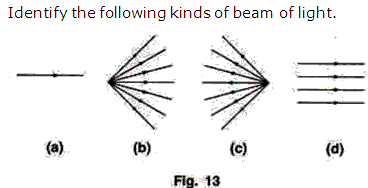
Solution 1
(a). A ray of light
(b). Divergent beam of light
(c). Divergent beam of light
(d). Parallel beam of light
(b). Divergent beam of light
(c). Divergent beam of light
(d). Parallel beam of light
Question 2
Name the substance through which light is made to pass.
Solution 2
The substance through which light is made to pass is called medium.
Question 3
What is meant by rectilinear propagation of light?
Solution 3
Rectilinear propagation of light is that the light travels along a straight line.
Question 4
Is glass an opaque medium?
Solution 4
No, glass is a transparent medium.
Question 5
Are metals transparent by nature?
Solution 5
No, no metal is transparent by nature.
Question 6
What is the difference between a ray of light and a beam of light?
Solution 6

Question 7
Out of the following, chose the substance which is translucent medium:
Wood, water, waxed paper, stone, black paper.
Wood, water, waxed paper, stone, black paper.
Solution 7
Waxed paper is the translucent medium among the given substances.
Question 8
Draw diagrams to illustrate the parallel, convergent and divergent beam of light.
Solution 8
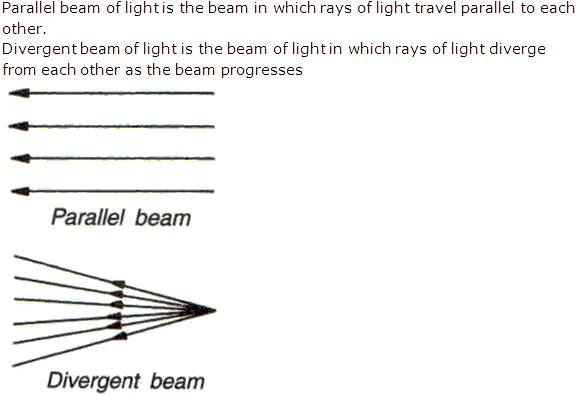
Question 9
Give two common observations illustrating that light travels in a straight line path.
Solution 9
Two observations that proves that light travels in a straight line are :-
(a). Sunlight coming through a hole in a dark room, we can easily see that light travels in a straight line
(b). Light coming from a laser light, used for presentation, can also be seen to travel in straight line.
(a). Sunlight coming through a hole in a dark room, we can easily see that light travels in a straight line
(b). Light coming from a laser light, used for presentation, can also be seen to travel in straight line.
Question 10
What do you mean by reflection?
Solution 10
When rays of light fall on a surface, they are turned back into the same medium in accordance with some definite laws. This process is known as reflection.
Question 11
What is the cause of regular reflection?
Solution 11
A smooth and polished flat surface is the cause of regular surface.
Question 12
State the laws of reflection.
Solution 12
Reflection obeys following two laws
(a). The incident ray, the reflected ray, and the normal at the point of incidence, all lie in the same plane.
(b). The angle of incidence and the angle of reflection are always equal.
(a). The incident ray, the reflected ray, and the normal at the point of incidence, all lie in the same plane.
(b). The angle of incidence and the angle of reflection are always equal.
Question 13
What must be the minimum height of a plane mirror so that 1.6 m tall person can see his full image?
Solution 13
The height of plane mirror should be half of the size of the object to get a full image of the object. So for a man of height 1.6 m tall should use a 0.8m tall plane mirror.
Question 14
What is meant by rectilinear propagation of light?
Solution 14
Rectilinear propagation of light is that the light travels along a straight line.
Question 15
What is meant by lateral inversion?
Solution 15
Lateral inversion is the reversal of image experienced in a plane mirror. The image is of the same size and equidistant from the object but the left and right sides are transposed.
Question 16
Name one phenomenon which is based on the laws of reflection.
Solution 16
Formation of image is the phenomenon based on laws of reflection.
Question 17
Name the principle employed in a periscope.
Solution 17
The principle employed in a periscope is successive reflections from two plane mirrors.
Question 18
What do you mean by the point of incidence?
Solution 18
The point at which the light is incident on the reflecting surface is called the point of incidence.
Question 19
What do you mean by a mirror?
Solution 19
Any smooth, highly polished reflecting surface is called mirror.
Question 20
What is meant by a plane mirror?
Solution 20
A smooth, highly polished plane surface is called plane mirror.
Question 21
Name the angle between the incident ray and the normal to the surface at the point of incidence.
Solution 21
The angle between the incident ray and the normal to the surface at the point of incidence is called the angle of incidence.
Question 22
The angle of incidence is 200. What is the angle between the incident and the reflected rays?
Solution 22
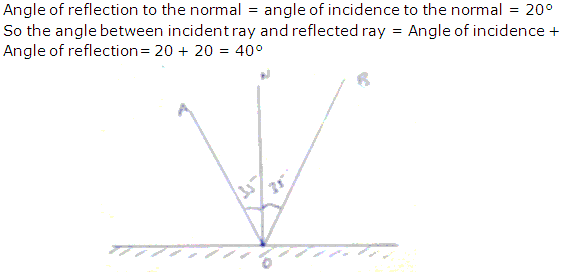
Question 23
The angle between an incident ray and the mirror is 350.
(i) What is the angle of incidence?
(ii) What is the angle of reflection?
(iii) What is the total angle turned by the ray of light?
(iv) What is the angle between the incident and the reflected rays?
(i) What is the angle of incidence?
(ii) What is the angle of reflection?
(iii) What is the total angle turned by the ray of light?
(iv) What is the angle between the incident and the reflected rays?
Solution 23
Given, angle between incident ray and mirror = 35o
(a). Angle of incidence = angle of mirror to the normal - angle between incident ray and mirror
= 90 - 35 = 55o
(b). Angle of reflection = angle of incidence = 55o
(c). Total angle turned = angle of incidence + angle of reflection
= 55 + 55 = 110o
(d). The angle between incident ray and reflected ray = Angle of incidence + Angle of reflection = 55 + 55 = 110o
(a). Angle of incidence = angle of mirror to the normal - angle between incident ray and mirror
= 90 - 35 = 55o
(b). Angle of reflection = angle of incidence = 55o
(c). Total angle turned = angle of incidence + angle of reflection
= 55 + 55 = 110o
(d). The angle between incident ray and reflected ray = Angle of incidence + Angle of reflection = 55 + 55 = 110o
Question 24
A boy is standing in front of a plane mirror at a distance of 3 m from it.
(i) What is the distance between the boy and his image?
(ii) If the boy moves 1 m backward, find the distance between the image and the boy.
(i) What is the distance between the boy and his image?
(ii) If the boy moves 1 m backward, find the distance between the image and the boy.
Solution 24
Given, distance of boy from the mirror = 3 m
(a). Distance of image from mirror = distance of boy from the mirror = 3 m
Distance between boy and his image = distance of boy from the mirror + distance of image from mirror = 3+3 = 6 m
(b). Now, distance of boy from the mirror = 4 m
Distance of image from mirror = 4 m
Distance between boy and his image = distance of boy from the mirror + distance of image from mirror = 4+4 = 8 m.
(a). Distance of image from mirror = distance of boy from the mirror = 3 m
Distance between boy and his image = distance of boy from the mirror + distance of image from mirror = 3+3 = 6 m
(b). Now, distance of boy from the mirror = 4 m
Distance of image from mirror = 4 m
Distance between boy and his image = distance of boy from the mirror + distance of image from mirror = 4+4 = 8 m.
Question 25
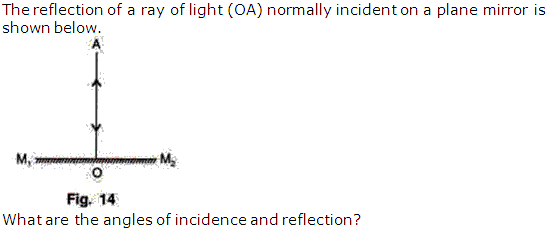
Solution 25

Chapter 6 - Light - Reflection of Light Exercise 247
Question 1
State two main characteristics of the image formed by a plane mirror.
Solution 1
Two characteristics of image formed by plane mirror are
(a). Image is erect and virtual
(b). Image and object are of same size.
(a). Image is erect and virtual
(b). Image and object are of same size.
Question 2

Solution 2

Question 3
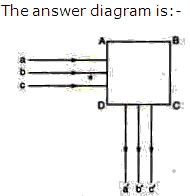
Solution 3

Question 4
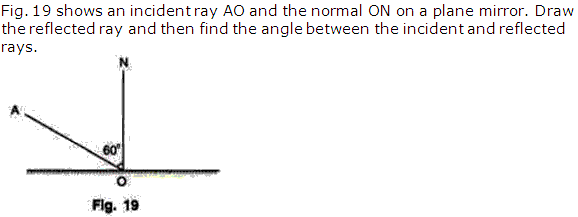
Solution 4
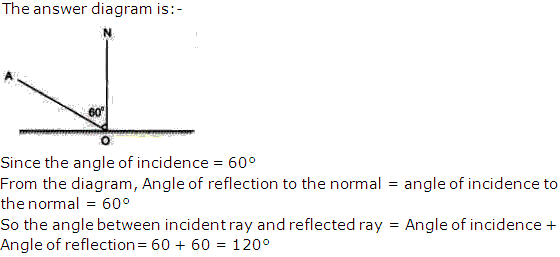
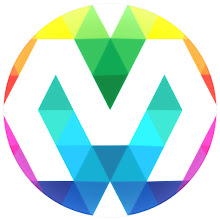
0 comments:
Post a Comment